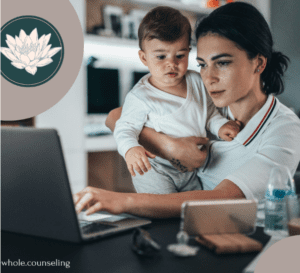Working mamas, this one’s for you!
As a working mother, it’s not uncommon to feel like you’re in a constant state of “doing mode”. The pressures of work and motherhood can feel like a never-ending cycle of tasks and responsibilities. This can be exhausting and stressful, leaving many mothers feeling burned out and overwhelmed.
To understand the impact of this constant “doing mode,” let’s take a look at the human stress cycle. When we are faced with a stressful situation, our body goes through a series of responses known as the stress response. This response begins with the release of hormones such as adrenaline and cortisol, which prepares our body for a fight or flight response. Once the stressful situation has passed, our body ideally returns to its natural state of balance or homeostasis.
However, when we are in a constant state of stress, we can get stuck in the resistance phase of the stress cycle, where our body is still in a heightened state of arousal even though the stressor has passed. This can lead to chronic stress, which is associated with numerous negative health outcomes such as depression, anxiety, and heart disease.
For working mothers, the constant state of “doing mode” can keep them stuck in the resistance phase of the stress cycle, preventing them from fully recovering from their daily stressors. This can lead to exhaustion and burnout, making it even more difficult to manage the demands of both work and home life.
To combat this, evidence-based recommendations suggest completing the stress cycle before transitioning from work mode to mom mode each day. This means engaging in activities that help your body return to its natural state of balance, such as:
- Exercise releases endorphins, which are natural stress-fighters that can help reduce the levels of stress hormones in the body. Engaging in 30 minutes of moderate to vigorous exercise, such as jogging or cycling, can help your body recover from the stress of the workday and transition to a more relaxed state for home life.
- Mindfulness practices have been shown to reduce stress and improve well-being by promoting relaxation and calming the mind. Mindfulness can be practiced in a variety of ways, such as focusing on your breath or body sensations, or through guided meditations.
- Spending time in nature has also been shown to be an effective way to complete the stress cycle. Being in nature can have a calming effect on the body, reducing stress and promoting relaxation. Taking a walk in the park, gardening, or simply sitting outside for a few minutes can be a great way to recover from the stress of the workday.
- Affection, such as hugging a loved one or cuddling with a pet, has been shown to release oxytocin, a hormone that can counteract the effects of stress hormones like cortisol. In fact, research has found that oxytocin can help lower blood pressure, decrease heart rate, and reduce anxiety.
- Laughter is another powerful tool for completing the stress cycle. Laughing can help reduce stress hormones, increase the production of feel-good endorphins, and promote relaxation. In addition, laughter can help improve mood, boost immunity, and even relieve pain.
- Crying can be powerful ways to complete the stress cycle. Many people feel embarrassed or ashamed to cry, but it is a natural and healthy response to stress. Crying can release pent-up emotions, allowing us to process and release stress from the body. Crying has been shown to reduce levels of cortisol, a stress hormone, in the body. In fact, studies have found that people who cry often have lower levels of stress and better overall mental health.
- Emotional expression to a trusted friend or therapist, can also be effective in completing the stress cycle. When we express our emotions in a safe and supportive environment, we can feel validated and understood, which can help us process and release stress
The constant pressure of being a working mother can lead to chronic stress and burnout, which can negatively impact both your work and home life. By taking the time to complete the stress cycle before transitioning from work mode to mom mode, you can help your body recover from the stress of the day and better manage the demands of both roles.
Learn more about the stress cycle and learn tangible, mindfulness-based stress reduction strategies coping with stress. Visit our website to download our free guidebook with guided practices and reflections: www.wholecounselingwellness.com

